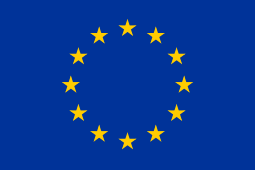 | |
| European flag Flag of Europe Flag of the Council of Europe Flag of the European Union Circle of stars | |
| Use |
|
|---|---|
| Proportion | 2:3 |
| Adopted | 9 December 1955[1][2] (CoE) 29 June 1985[3] (EEC) |
| Design | A circle of twelve five-pointed yellow stars on a blue field. |
| Designed by | Collaborative effort involving various people, including Arsène Heitz and Paul M. G. Lévy |
The flag of Europe or European flag[note 1] consists of twelve golden stars forming a circle on a blue field. It is the official flag of the European Union. It was designed and adopted in 1955 by the Council of Europe (CoE) as a symbol for the whole of Europe.[4]
Since 1985, the flag has also been a symbol of the European Union (EU), whose 27 member states are all also CoE members, although in that year the EU had not yet assumed its present name or constitutional form (which came in steps in 1993 and 2009). Adoption by the EU, or EC as it then was, reflected long-standing CoE desire to see the flag used by other European organisations.[5] Official EU use widened greatly in the 1990s. Nevertheless, the flag has to date received no status in any of the EU's treaties. Its adoption as an official symbol was planned as part of the 2004 European Constitution but this failed to be ratified. Mention of the flag was removed in 2007 from the text of the Treaty of Lisbon, which was ratified. On the other hand, 16 EU members that year, plus France in 2017, have officially affirmed (by Declaration No. 5224) their attachment to the flag as an EU symbol.
The flag is used by other European entities, such as unified golf teams under the rubric Team Europe.[6]
- ^ "The European flag". Council of Europe. Retrieved 8 December 2020.
- ^ "Emblème du Conseil de l'Europe". Council of Europe. 9 December 1955. Retrieved 8 December 2020.
- ^ Cite error: The named reference
COE pagewas invoked but never defined (see the help page). - ^ The European flag, Council of Europe. Retrieved 27 October 2016.
- ^ "The European flag". The Council of Europe in brief. Retrieved 2 July 2020.
- ^ "Teams at the 2020 Ryder Cup at Whistling Straits, Kohler, WI, Sept. 22-27 brought to you by Rydercup.com". Archived from the original on 15 June 2019. Retrieved 3 October 2019.
Cite error: There are <ref group=note> tags on this page, but the references will not show without a {{reflist|group=note}} template (see the help page).